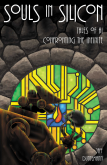I’m fascinated by the Victorian/Edwardian period of history, which is where steampunk is usually set, as well as weird westerns. My WIP drumlins novel The Everything Machine is in some respects a space western. But quite apart from a lot of other fascinating things from that era (The Great Eastern! Brunel!) there is the puzzle of spiritualism. It’s that time of year again, so I can ask and perhaps answer a question that popped up as I read about the phenomenon of spiritualism, which was quite the thing in the Victorian era and for some time after, from roughly 1850 until 1940. It came out of nowhere and spread explosively, then vanished almost as quickly. Yes, there are a few spiritualist churches still in operation, but they’re notable not because of their ubiquity but because of their scarcity.
Here’s the (double) question: Why did spiritualism appear? And why did it vanish?
My tl-dr answer: Lotsa deaths. Also antibiotics, and television. Let’s talk about that.
Most people agree that spiritualism began in 1848 in the farm town of Hydesville, outside Rochester NY. There were two young sisters living in a small house with their parents. As you’ll note if you read Colin Wilson’s excellent Poltergeist (see yesterday’s entry) having pubertal girls in a house is practically begging for poltergeist activity.
And so it was. In the house of the Fox family, there began all the usual: scratchings, bangings, growls, raps, and more bangings. Some of the booms could be heard over a mile away. (Subwoofers didn’t exist in 1848.) Katie, the younger sister at 12, was a bit of a snot. The general assumption was that the noises were the work of the devil. So Katie jumps up in the midst of audio pandemonium, and yells, “Here, Mr. Splitfoot, do as I do!” She then pounded the kitchen table twice with her fist. The noise stopped for a moment, then two loud raps answered. Katie and her older sister Margaretta listened to the invisible whatsit echo their own noises, then established a sort of code for answers: noise (of whatever sort) meant “yes.” Silence meant “no.” Using this code, they questioned the family poltergeist, and soon established a more complex code for spelling out words. The poltergeist claimed to be the spirit of a dead peddler who had been murdered and buried beneath the cellar of the house. He gave his name as Charles Rosma, and a little digging in the cellar and behind a wall turned up bones and a peddler’s carry box used for door-to-door sales work.
The story spread like wildfire across America and then across the Atlantic to Europe, and soon lots of other people were talking to “spirits” via pounding on tables or—later—making the tables tap out codes with their legs. After that came the “planchette,” which is a kind of pointer, to be used on a board printed with the alphabet. (These were not called “ouija boards” for quite awhile after.)
Certain people had a talent for talking to whatever was tipping tables or moving planchettes around. Other people didn’t, but tried it anyway—and in some cases, got some minor interactions. By the 1860s, formal spiritualist groups coalesced around the world, many claiming to be parts of a new religion. By the 1880s, spiritualism had also become a sort of parlor game played by groups of bored teens and young adults, some of whom freely admitted moving the planchette or table with their own muscles. After all, you had to touch the planchette or table with human hands to make it work. Faking it was easy, and getting laughable answers was the goal of the game.
Down the years after 1850, different methods of talking to dead guys appeared: automatic writing, trance mediums, and direct voice, among others. Despite being a game for many young people, it was taken seriously by many adults, and a spiritualist canon (most produced by automatic writing) appeared, explaining what spirits do on the job and off, where they go to school, and what sorts of surroundings they live in. Spirits claiming to be deceased relatives of the “sitters” (the people attending what later became known as seances) came through often, sometimes to say very little more than “I’m all right! It’s beautiful here! Can’t wait to see you again!” Despite a slightly grim edge to such communications, people were ecstatic to hear from their dear departed. There was plenty of religion abroad in the Victorian era, but spiritualism offered something none of the other religions could: Messages from departed loved ones.
Something people now in the 21st century generally fail to understand is that there were a lot of departed loved ones back then. And not just old people. Many children died of diseases like diphtheria, pneumonia, or that hideous killer “consumption”: the Victorian term for tuberculosis. Spouses became widowed far earlier and oftener than now. Death in childbirth was common, and supposedly happened to one in twenty pregnant women trying to give birth. Stillborn children and infants who lived for only a day or even a few hours were quite common.
If you read the contemporary literature of spiritualism (I have) it becomes obvious that everybody back then had deceased loved ones: parents, children, infants, grandparents, spouses, close friends.
Everybody.
There was a huge market for Spiritualism (I’ll cap it now because it had become a global movement/religion and not merely an idea) and Spiritualism catered very well to that market. Spiritualism cruised along at full roar (or maybe full bang) for decades. It reached what might be considered its peak during WWI, when a great many new deceased love ones happened. After WWI and the Spanish Flu of 1918, death rates continued to fall due to chlorinated water, indoor plumbing, sanitation in medicine and the first vaccines. Penicillin appeared in 1942, and it was the first antibiotic of many. People no longer died from infected minor cuts and scratches.
Once WWII was over, death was no longer an everyday thing in American life and elsewhere in the developed West. People were (mostly) living their threescore-and-ten, and death in childbirth was not the scourge it had been in the 1890s. The demand for talking to dead people was nowhere near as strong. The supply of seances and mediums thinned out. Little by little, people lost interest.
That was Spiritualism’s first whammy. There was another.
In the last quarter of the 19th Century, entertainment was scarce, and mostly confined to the well-off. There were concerts. But there was no broadcast radio, and until the 1920s, few phonographs. For music in the 1880s, it was concerts or nothing. (Or in some cases playing your own piano.) Concerts cost money, as did plays. So what did bored young people do for entertainment?
Table-tipping. Planchettes. It was a craze. It was cheap. Modern histories generally don’t state this, but if you read the contemporary reports, seances had become a parlor game.
Fast-forward to 1930. There was radio. There were movies. Not free—but increasingly inexpensive as time went on. Seances had competition. Then, in 1948, TV happened in a big way. Sets were still expensive, and until the early-mid 1950s people often watched them in bars. But demand brought down prices, and by 1955, TV ruled the entertainment world.
How could seances compete with Sid Caesar?
They didn’t. Spiritualism became an eccentric current in an increasingly distant past. Now, there’s an asterisk to this story: In the early 1960s, Parker Brothers (the game people, makers of Monopoly) bought the rights to a product called Ouija, which had been produced and sold since 1910 or so by a William Fuld. It was basically an inexpensive prefab planchette system. By 1965 Parker Brothers was targeting Ouija at tweens and teens with commercials on both radio and TV. I was there; I saw them. The girl down the block got one for her birthday and twisted my arm into trying it with her. Nothing happened. She was annoyed. I was relieved.
Many millions of boards were sold. In 1968, in fact, Ouija outsold Monopoly, which boggles my mind, at least. I wonder how many people actually treated the “game” seriously. I also wonder how quickly the damned things went into the trash.
That’s the story as I understand it. When death was an everyday thing, the demand for Spiritualism was high. As death rates went down and death became a sad but uncommon occurrence (compared to the midlate 1800s) the demand went off a cliff. Parker Brothers tried making it a game, and although I have no real data, no one I knew except the girl down the street had a Ouija board.
As with poltergeists, I take no particular position on Spiritualism. NDEs and channeling have taken over nickel-and-dime afterlife exploration. A couple of weird events in my life suggest that there is an afterlife, and it’s a fundamental concept in Catholicism, if not described well. I’ll take author John Hick’s opinion as my own: It’s there, but we won’t know what it’s like until we get there.
I’m good with that.













